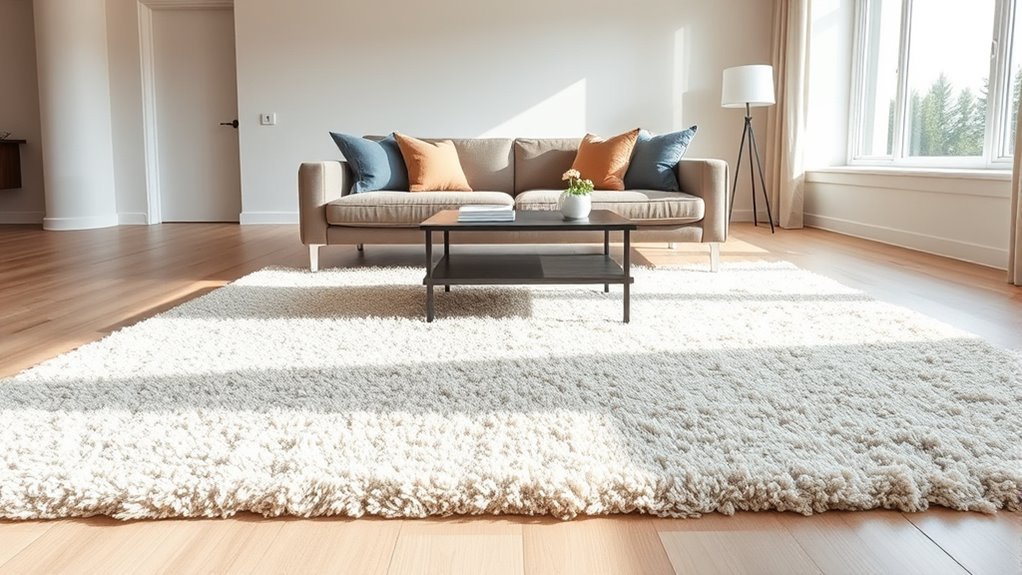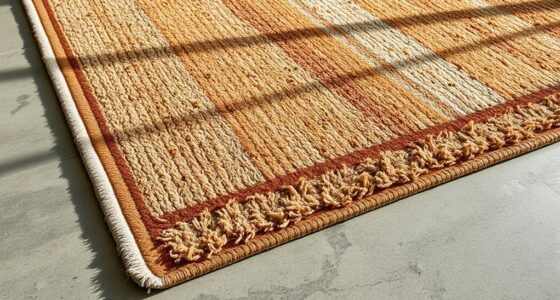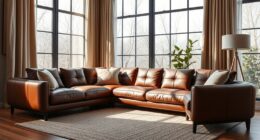Start by measuring your space to choose a rug size that complements your furniture and room layout. Consider the room’s function and how you want it to feel—cozy or open. Keep borders a few inches from furniture and walls for a clean look. Use visual cues like windows or art for placement and layer rugs for added depth. Pay attention to color, pattern, and finishing touches for cohesion. For more expert tips, explore what follows.
Key Takeaways
- Measure your space carefully, leaving 1-3 inches of border clearance around furniture and walls.
- Anchor furniture by choosing a rug large enough to fit all legs on or around it for a cohesive look.
- Match rug size and pattern to room function and furniture layout for balanced visual appeal.
- Use layering and complementary colors or patterns to enhance aesthetic harmony and add texture.
- Incorporate non-slip pads and make small adjustments after placement for safety and a polished appearance.
Measure Your Space Before Buying
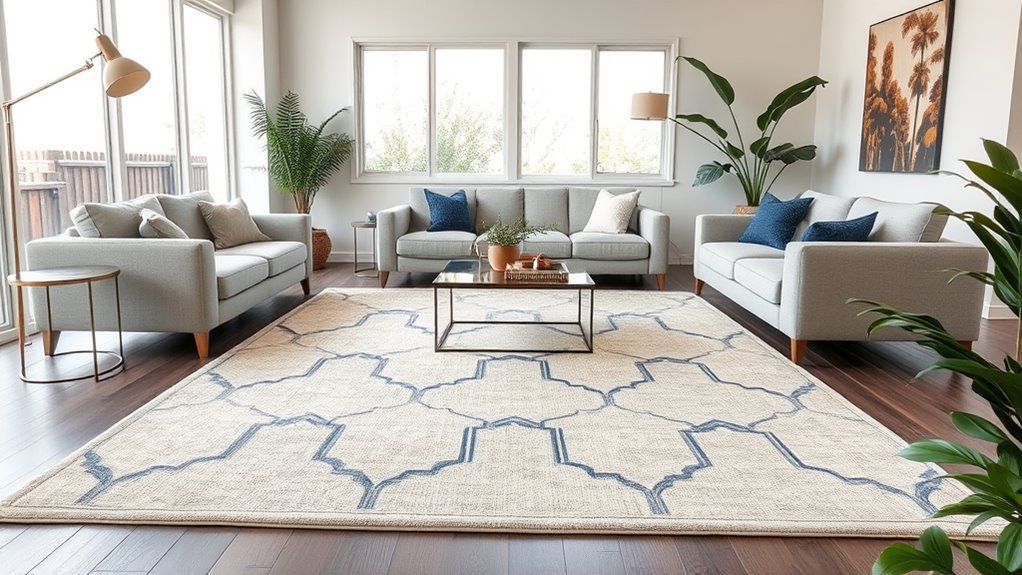
Before purchasing a rug, it is vital to gauge your space accurately. Proper area measurement ensures the rug fits perfectly and enhances your room’s overall design. Use a tape measure to determine the length and width of the area you want to cover. Don’t forget to account for clearance space around furniture and walls, which is essential for effective space planning. Visualize the rug within your room’s layout to avoid overcrowding or underwhelming proportions. Taking precise measurements helps you select a rug size that complements your furniture and room dimensions. Additionally, considering rug size and placement can significantly influence the room’s aesthetic and functionality. For example, choosing the right rug size can help prevent overcrowding or create a focal point. Remember, a well-measured rug can anchor your space and create a balanced, cohesive look. Ensuring proper furniture arrangement can further optimize how your rug enhances the room’s overall harmony. Understanding best rug sizes for different spaces can also guide you in making the most suitable choice.
Consider the Function of the Room

Understanding how you’ll use a room is essential when choosing the right rug size and placement. If it’s a space for entertaining, you might want a larger rug that anchors your seating area and highlights decorative accents like artwork or vases. For a cozy reading nook, a smaller rug can add warmth without overpowering the space. Consider lighting when selecting your rug; natural light can make bright patterns pop, while softer lighting calls for more subdued tones. The room’s function influences the rug’s durability and style—high-traffic areas need sturdy, easy-to-clean options. Additionally, the type of decor, such as Antiques, can complement your rug choice to create a cohesive aesthetic. Incorporating antiques can also add character and a sense of history that enhances your overall interior design. Practicing space organization can help you visualize how different rug sizes will fit within your space and improve the room’s flow. Incorporating knowledge about essential oils can subtly influence the ambiance and mood of the room through scent, creating a more inviting environment. Ultimately, your rug should enhance the space’s purpose, complement the decor, and create a welcoming atmosphere aligned with how you plan to use the room daily.
Choose the Right Rug Size for Your Furniture Layout
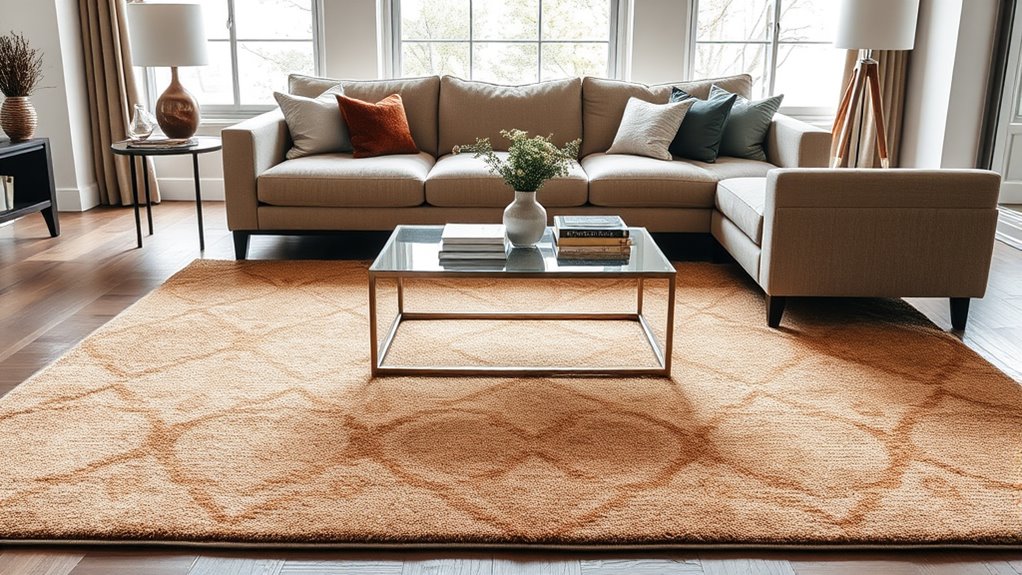
Choosing the right rug size helps anchor your space and creates a balanced look. When your furniture fits well on the rug, the arrangement feels intentional and cohesive. Pay attention to how the rug complements your furniture layout to achieve harmony. Incorporating rustic decor elements can further enhance the cozy farmhouse ambiance and tie the room together seamlessly. Additionally, selecting the appropriate rug size can influence the overall style and functionality of your room, making it feel more inviting. Understanding the spatial planning involved in interior design ensures that your rug choice enhances both the aesthetic and practical aspects of your space.
Anchoring Your Space
Selecting the right rug size is vital for grounding your furniture and creating a balanced, cohesive space. To effectively anchor your room, consider how the rug interacts with your furniture and overall layout. Texture pairing plays a key role—mix soft, plush rugs with sleek, smooth textures to add visual interest. Material selection also impacts the room’s feel; natural fibers like jute or wool add warmth, while synthetic options can introduce durability. Make sure your rug complements your furniture style and size, providing enough coverage to unify the space without overwhelming it. When placed correctly, your rug becomes the anchor, guiding the eye and establishing a harmonious foundation for your entire room. Incorporating farmhouse textiles principles can also help in visualizing and planning your space more effectively. Additionally, considering the water-resistant properties of certain materials can be beneficial in high-traffic or spill-prone areas. Proper air purifier maintenance can also help create a healthier indoor environment that complements your decor choices.
Balancing Furniture Layout
Properly balancing your furniture layout starts with picking the right rug size to complement your space. A well-chosen rug anchors the furniture and enhances the room’s overall flow. To achieve this, consider these tips:
- Ensure all furniture legs sit on the rug for a unified look and better color coordination.
- Choose a size that allows enough space around furniture for walking without appearing cramped.
- Use lighting effects to highlight the rug and furniture, creating depth and visual interest.
- Balance the layout by aligning furniture with rug edges, preventing any awkward gaps or overcrowding.
- Incorporating sustainable materials in your rug selection can also emphasize eco-friendly interior design choices.
- Selecting the appropriate rug size ensures harmony between your furniture and the overall room design, making your space feel more cohesive.
- Considering the water park theme and playful elements can inspire fun and vibrant rug choices that energize your room.
- Consulting professionals or trusted sources can help navigate interior design principles and ensure your rug choice complements your entire space.
Maintain Proper Rug Border and Edge Clearance
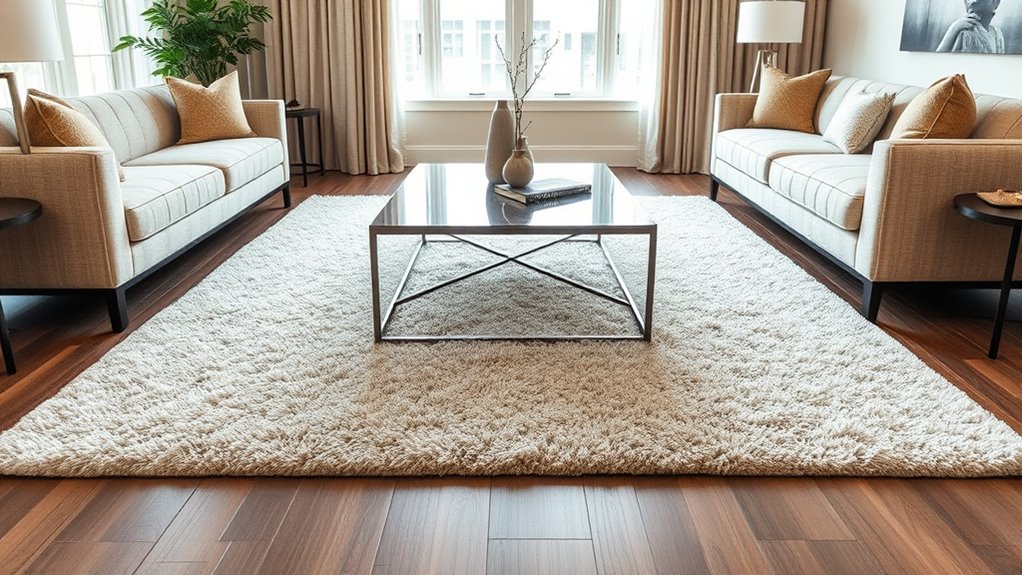
Maintaining an adequate border and edge clearance around your rug not only enhances safety but also creates a balanced, polished look in your space. Proper border clearance ensures your rug doesn’t overpower the room or look cramped. Aim for consistent edge spacing — typically 1-3 inches from furniture or walls — to achieve harmony. Use the table below to visualize ideal border clearance based on rug size:
| Rug Size | Border Clearance | Purpose |
|---|---|---|
| Small (3×5 ft) | 2 inches | Defines space without crowding |
| Medium (5×8 ft) | 3 inches | Balances furniture anchoring |
| Large (8×10 ft) | 4 inches | Creates a spacious feel |
| Extra Large | 4-6 inches | Highlights the rug as focal point |
Additionally, support hours for stores and attractions can influence your planning, so it’s helpful to check operating times in advance to ensure a smooth experience. Incorporating proper rug size considerations can significantly impact the overall aesthetic and functionality of your space, especially when considering interior-design principles that emphasize balance and proportion. Understanding acne patches and their proper use can also be beneficial for skincare routines, ensuring clear and healthy skin as part of your overall well-being.
Use Visual Cues to Guide Placement
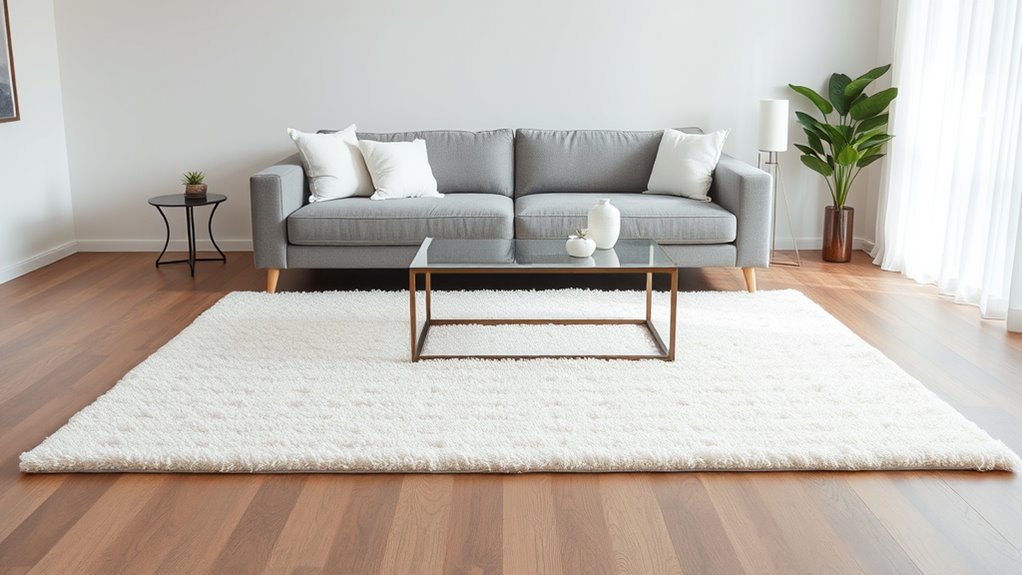
Using visual cues is an effective way to guarantee your rug placement feels natural and balanced. These cues help your eye interpret space and create harmony. To enhance your placement strategies, consider these tips:
- Align the rug with furniture edges or architectural features for cohesive flow.
- Use wall art, windows, or doorways as reference points to center or position your rug.
- Maintain consistent spacing around furniture to create visual balance.
- Pay attention to negative space—leave enough room around the rug to avoid a crowded look.
Layer Rugs for Added Depth and Style
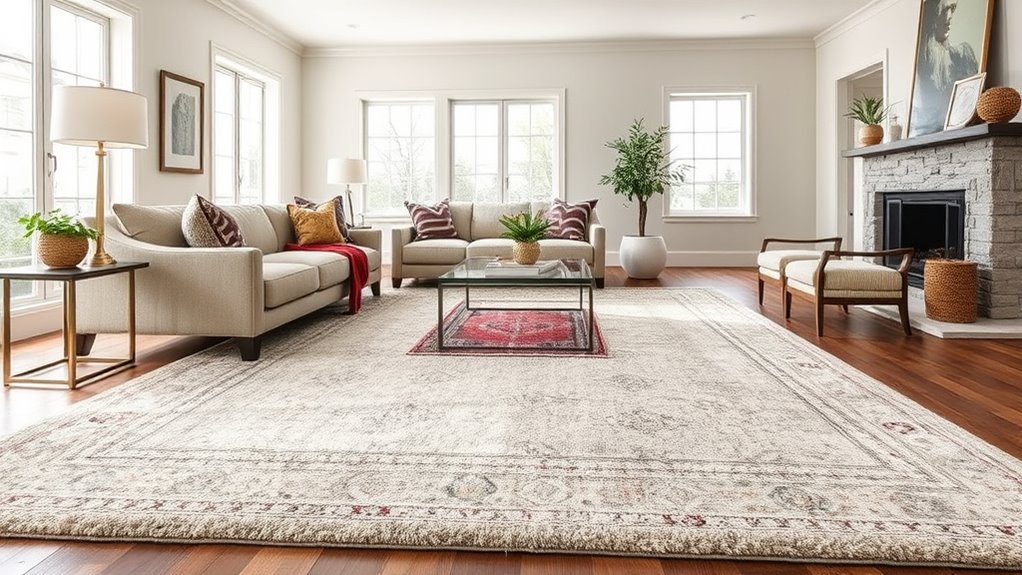
Layering rugs can instantly add depth and personality to your space, making it feel more inviting and curated. Use layering techniques to create visual interest through textural contrast—combine rugs with different fibers, pile heights, or weaves. For example, place a flat-woven rug over a plush, shaggy one to add dimension and tactile variety. Keep in mind that strategic layering can highlight specific areas, like a seating zone or entryway. Be intentional with size and placement: a smaller rug layered over a larger one can define an area without overwhelming the room. This technique not only enhances style but also adds warmth and comfort, turning an ordinary space into a thoughtfully designed environment.
Think About Color and Pattern Balance

When choosing a rug, make sure it complements your room’s color palette to create harmony. Balance bold patterns with more subdued ones, so your space feels cohesive rather than chaotic. Also, coordinate the rug’s colors and patterns with your furniture to enhance the overall style.
Harmonize With Room Palette
To create a cohesive look, you need to contemplate how your rug’s colors and patterns work with the overall room palette. Achieving good color harmony ensures your rug complements existing furniture and decor. Focus on palette coordination by selecting hues that either match or subtly contrast with your room’s dominant colors.
Consider these tips:
- Match rug colors with key furniture pieces for seamless integration.
- Use patterns that echo or enhance your room’s existing decor for visual harmony.
- Balance bold patterns with neutral tones to avoid overwhelming the space.
- Incorporate accent colors from your room’s palette to create a unified look.
Balance Pattern Intensity
Balancing pattern intensity involves careful consideration of how bold or subtle your rug’s design interacts with the rest of the room. Pay attention to the pattern scale—large, dramatic patterns create a strong visual weight, making them ideal for neutral or minimally patterned spaces. Conversely, smaller, intricate patterns add subtlety without overwhelming the room’s harmony. You want to create a sense of visual balance, so choose a rug whose pattern intensity complements your furnishings and wall treatments. If your furniture has bold colors or patterns, opt for a rug with a more subdued design. This balance in pattern scale and visual weight prevents any one element from dominating, resulting in a cohesive, inviting space that feels thoughtfully curated.
Coordinate With Furniture
Coordinating your rug with furniture involves paying close attention to both color and pattern to create a harmonious look. To achieve this balance:
- Match or complement the dominant colors of your furniture and decorative accents to guarantee cohesion.
- Balance patterns by pairing bold, patterned rugs with solid furniture or vice versa, preventing visual overload.
- Consider lighting placement, as proper illumination highlights rug details and enhances color harmony.
- Use lighting and accents to draw attention to the rug’s pattern, creating a unified aesthetic.
Use Rug Pads to Secure and Protect
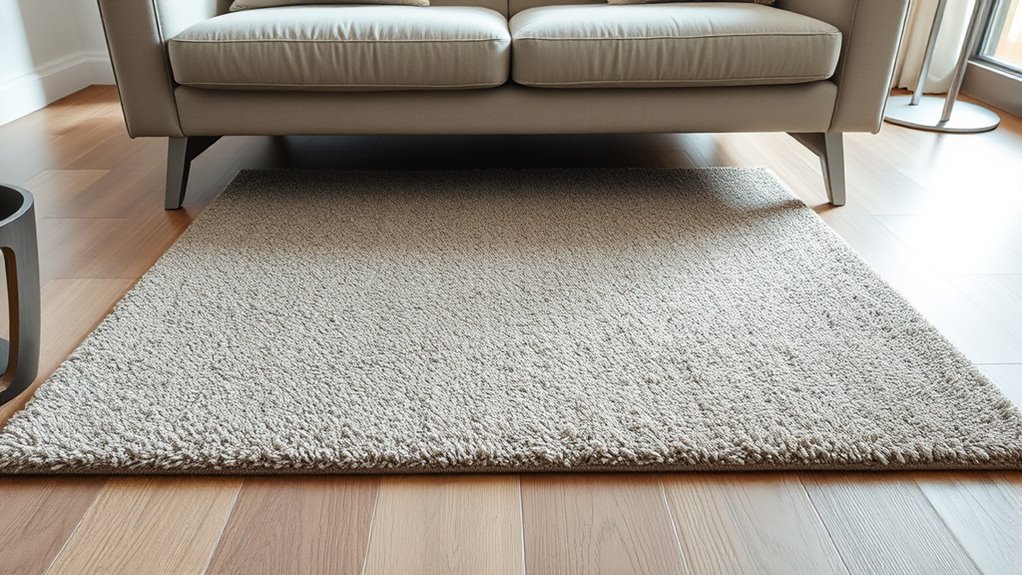
Rug pads are essential for ensuring your rug stays securely in place and protecting your flooring from damage. A non slip rug pad provides the grip needed to prevent slipping and bunching, especially on smooth surfaces like hardwood or tile. Rug padding also adds cushioning, extending the life of both your rug and your floors. When choosing a rug pad, opt for one that matches your rug’s size and shape to avoid slipping or bunching. Installing a quality rug pad is simple—just place it underneath your rug before laying it down. This not only enhances safety but also helps maintain your rug’s appearance over time. Keep your space secure and damage-free by investing in the right rug padding for your needs.
Adjust and Fine-Tune for a Cohesive Look
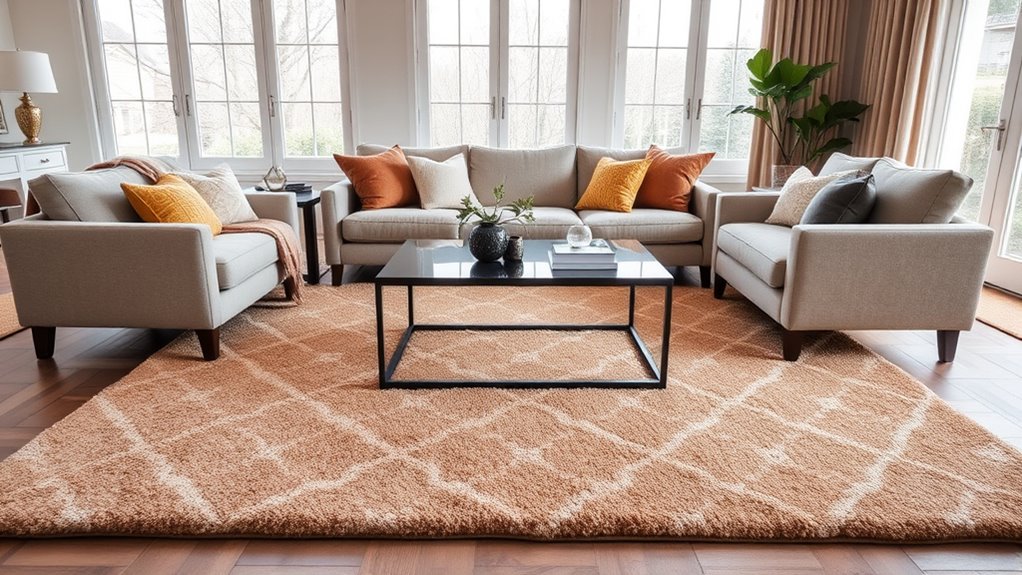
Once you’ve placed your rug, take a moment to step back and assess how it fits within the overall space. Fine-tuning guarantees a cohesive look by adjusting for balance and style. Consider these steps:
- Rearrange decorative accents like cushions or vases to complement your rug’s colors and patterns.
- Check lighting considerations—adjust lamps or curtains to highlight the rug without creating glare or shadows.
- Ensure furniture placement aligns with the rug’s edges, maintaining visual harmony.
- Make small shifts in the rug’s position if needed, so it anchors the space perfectly and feels intentional.
These adjustments help create a polished, unified look that enhances your room’s decor and ambiance.
Frequently Asked Questions
How Do I Choose a Rug That Complements My Existing Decor?
When choosing an area rug that complements your existing decor, focus on color coordination to create harmony. Select a rug with colors that echo or complement your furniture and accessories. Consider the style and overall palette of your space, and opt for a rug that enhances without overpowering. By balancing patterns and textures, you’ll find the perfect area rug that ties your decor together effortlessly.
What Materials Are Best for High-Traffic Areas?
Did you know high-traffic areas see up to 10 times more wear? For durability considerations, choose materials like nylon or polypropylene, which are known for their resilience. They also offer excellent stain resistance, making cleanup easier. Wool is another great option because it’s durable and naturally stain-resistant, but it may require more maintenance. Prioritize these materials to guarantee your rug withstands daily use while maintaining its appearance.
How Often Should I Rotate or Clean My Rug?
You should follow a regular rug cleaning schedule, ideally vacuuming weekly to keep dirt at bay. For high-traffic areas, consider rotating your rug every 6 to 12 months to guarantee even wear and prolong its life. Deep cleaning or professional cleaning should be done at least once a year, or more often if you notice stains or heavy dirt. This routine helps maintain your rug’s appearance and longevity.
Can a Rug Make a Small Room Appear Larger?
Ever wondered if a rug can make a small room seem bigger? Yes, it can! A well-chosen rug creates a visual illusion of space by anchoring your furniture and defining the area. Lighter colors and larger sizes work best, making the room feel more open. You just need to strategically place the rug to enhance the flow and avoid clutter, transforming your small space effortlessly.
What Are Common Mistakes to Avoid When Placing Rugs?
When placing rugs, avoid common mistakes like misaligning furniture and rug edges, which can make the space feel disjointed. Make certain your furniture arrangement complements the rug, keeping pieces anchored and balanced. Don’t overlook color coordination; choose a rug that harmonizes with your room’s palette to create a cohesive look. Also, avoid placing rugs too small or too large for the space, as this disrupts visual harmony.
Conclusion
By following these tricks, you’ll master rug placement like a pro. Think of your space as a canvas, and your rug as the focal point that ties everything together. Take your time to measure, consider function, and play with colors and patterns. When done right, your room will feel as inviting as a cozy cafe. So, trust your instincts, make adjustments, and enjoy transforming your space into a stylish sanctuary.
